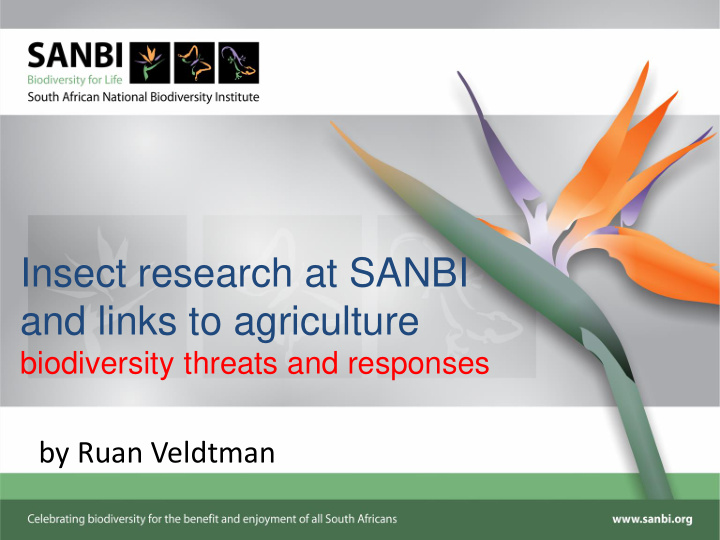



Insect research at SANBI and links to agriculture biodiversity threats and responses by Ruan Veldtman
Past & current SANBI projects • (P&R) Global Pollination Project – 2008 to 2014, 3MSc, 1PhD, 1pdoc; collaboration SU & UP • (R) Honeybee Forage Project – 2011 to 2015, 1MSc, 1PhD; collaboration SU, Strelitzia 37 • (P) Invasive wasp project – since July 2012, ongoing : 1 Hons, 2MSc, 2PhD, 1 Post doc, 1 international expert • (R) Ecological Infrastructure (EI) and pollination ongoing – EI and Agric
(2) Invasive wasps in Western Cape agriculture Pictures by Dr Simon van Noort Polistes dominula (Family Vespidae) or ‘European paper wasp’ Vespula germanica (Family Vespidae) or ‘German wasp’
The two culprits… Vespula germanica Polistes dominulus
German wasp invading the Western Cape
Paper wasp invading the Western Cape
German & Paper wasp’s distribution in SA
• Wasp biology and ecology : Phase I - student theses and publications. Some aspects ongoing, e.g. genetics • Wasp risk assessments : Ruan will discuss with Sabrina, Claude and John W to see who can do invertebrate RAs. • Economic costs of wasps invasion , including the cost of no action • Delimitation (requiring surveillance) : current ToR to survey the edges of current known distributions almost finalised • Eradication feasibility : current contracts to test management efficacy and cost of control (Grabouw, Franschhoek and possibly Wellington @ R300 K per town) • Detection, handling and storing public reports (spots), developing SANBI-ISP response protocols and distributing communication materials and possible citizen science part
Pollination of insect-dependent crops • Crop pollination by wild pollinators resident in neighbouring natural habitat = ecosystem service • Same crop pollinated by honey bees coming from hive boxes rented from a beekeeper is not • Thus can only make a case for biodiversity if crop uses the ecosystem service • First step is thus to determine what proportion of pollination is by wild versus managed honey bees
Global Spring ngbok ok Flats ts sunfl flow owers rs Pollination Project in SA • No payment for mgd bees • Vast landscapes • Attractive to pollinators • Payment for managed bees • Export regulations • Attractive to pollinators Biodiversity Hotspot! Little tle Karoo hybrid id onion seed • Payment for managed bees Boland nd, , Koue Biodiversity • Valuable export crop Bokke kevel veld & & Langkl kloo oof Hotspot! • Attractiveness variable apples
Main Production Areas in SA
Typical Site Natural Vegetation 2 3 1
Pollinator counts in apple orchards near and far from natural vegetation 120 100 % of total pollinator counts Away from natural 80 Near natural 60 40 20 0 Honeybees Diptera Lepidoptera 99% of apple farms make use of managed honeybees, irrespective of proximity to natural vegetation – represents only 1% of the production costs.
But why do we find these types of results?
B A C D
However honey bees are part of South Africa’s biodiversity Apis mellifera capensis Cape honeybee Apis mellifera scutellata African (Savanna) honeybee
Managed honey bees in South Africa • Beekeepers use the sub-species found in their region • Colonies are trapped and housed in hive boxes and some of them swarm-off and become wild • Thus NO genetic difference between managed and wild populations – robust to change • Most importantly, if honey bees cannot be sourced beekeepers can’t offer a pollination service • The number of colonies that can be kept, maintained and caught depends on forage plants
Crop pollination and wild vs managed pollination -associated dependencies
The Honeybee Forage Project Working for Water funding; 2011-2014 – Relative importance of forage resources – Spatial data of forage resources – Alternative forage resources – Optimal forage management – Supply and demand of honeybees in SA
Forage use for managed honeybees in Western Cape Pollination season eucalyptus apples weeds eucalyptus canola Jan-Feb Mar-Apr May-Jun Jul-Aug Sep-Oct Nov-Dec pears Fynbos Indigenous citrus natural veg fynbos Weeds Cultivated crops Exotics / aliens Honeybee Forage Project: what is the ECOLOGICAL INFRASTRUCTURE that supports this managed pollination service?
100 90 Eastern Cape 80 Tlou Masehela’s PhD Free State Percentage of colonies (%) 70 Gauteng research 60 KwaZulu-Natal Limpopo 50 Mpumalanga 40 Forage type contribution Northern Cape 30 North West to colony maintenance 20 Western Cape 10 0 Exotic forage Indigenous Forage Forage type 100.0 Eastern Cape 90.0 Free State 80.0 Percentage of colonies (%) Gauteng 70.0 KwaZulu-Natal 60.0 Limpopo 50.0 Mpumalanga 40.0 Northern Cape 30.0 North West 20.0 Western Cape 10.0 0.0 Eucalyptus Agricultural Suburaban Weeds Natural Vegetation crops plantings species or units species groups Forage type
Ecosystem service – disservice = societal benefit $7,500,000 - $348,148 = $ 7,151,852 per year or $20,500,000 de Lange, Veldtman & Allsopp 2013 Valuation of pollinator forage services provided by Eucalyptus cladocalyx . Journal of Environmental Management 125, 12-18. Gums represent valuable forage in the landscape
SANBI EI committee : “So how do we sell biodiversity to agriculture sector, given we know wild honey bee swarms are trapped, and managed honey bees use plant forage as ecological infrastructure and supporting infrastructure?”
Ecosystem services Ecological function Ecological Infrastructure Biodiversity
Fruitways : “ Bee Sanctuaries - initiative that we as the Groenlandberg Conservancy would like to get off the ground. We feel the idea of Bee Sanctuaries resonates with all our members and it’s a common objective that we can all aim to contribute towards. ” Stephen Rabe (Director – Fruitways Agri Services, Elgin, Grabouw)
Acknowledgments Mike Allsopp Pia Addison Tlou Masehela Matthew Addison Madelé Mouton Carol Poole Philip Ivey
Recommend
More recommend